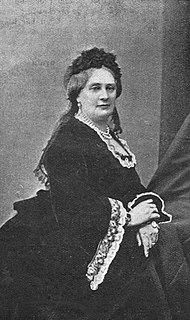
Ebba Magnusdotter Brahe was a Swedish countess, landowner, and courtier. She is foremost known for being the love object of King Gustavus Adolphus of Sweden, and because he wished to marry her prior to his marriage, plans which were however never realized. Their love affair has been famous in the Swedish romantic history and the subject of fiction, and are documented in their preserved correspondence.

Gustava Charlotta Jacquette Aurora Gyldenstolpe was a Swedish noble and lady-in-waiting. She is known as the mistress of Oscar I of Sweden in circa 1819-1827.

Göksholm is a medieval Swedish castle located on the southern beach of lake Hjälmaren. It is the oldest privately owned building in Sweden that has been continuously inhabited.

Hedvig Charlotta Nordenflycht was a Swedish poet, feminist and salon hostess.

Eva Ekeblad was a Swedish countess, salon hostess, agronomist, and scientist. She was widely known for discovering a method in 1746 to make alcohol and flour from potatoes, allowing greater use of scarce grains for food production, significantly reducing Sweden's incidence of famine.
Brita Olovsdotter Tott or Birgitte Olufsdatter Thott, , called the Lady of Hammersta, was a Danish and Swedish noble, landowner, royal county administrator, spy and forger. She was judged for treason and for the forgery of seals. She was one of the biggest landowners in Scandinavia, and her estates played a role in politics in Sweden and Denmark.
Elsa Beata Bunge, née Wrede,, was a Swedish, botanist, writer and noble.

Maria Sofia De la Gardie was a Swedish noble, countess, courtier, banker and industrialist entrepreneur. She is most known for her industrial enterprises, and she has been referred to as the first female grand entrepreneur of her country. She served as överhovmästarinna to Queen Christina of Sweden.

Ericsberg Palace is a palace in Sweden. It is situated outside Katrineholm in Katrineholm Municipality, Södermanland County.

Gyllebo Manor is a manor house in Simrishamn Municipality, Scania, in southern Sweden. Adjacent to the castle is Gyllebohus, the ruins of a 16th-century stronghold.

Skarhults Castle is a castle in Eslöv Municipality, Scania, in southern Sweden.
Barbro Eriksdotter Bielke, known in history as Barbro Påle and Fru Barbro på Brokind was a Swedish noble and landowner. She is known as the subject of a ghost story, in which she is claimed to haunt Brokind Castle. She is also known as one of the likely historical role models behind the legend of Pintorpafrun, a stereotypical cruel lady of the manor who tortures and mistreats her subordinates and haunts the place of her cruelty after her death. She reputed to be cruel toward her tenants and rumored to be a witch. Another person pointed out as the historical person behind pintorpafrun was Anna Karlsdotter (Vinstorpa).

Ulrika "Ulla" Lovisa Tessin née Sparre was a Swedish courtier, letter writer and dilettante artist.
Anna Karlsdotter (Vinstorpa), was a Swedish noble and landholder. By her daughter Ebba Eriksdotter Vasa, she was the maternal grandmother of Queen Margaret Leijonhufvud and thereby great grandmother of King John III of Sweden and King Charles IX of Sweden. She is remembered as one of several possible people later identified with the famous legend of Pintorpafrun.

Christina Piper, née Törne, was a Swedish countess, landowner and entrepreneur, married to the statesman and military count Carl Piper. During the tenure of her spouse in office, she played a considerable political role. Christina Piper became known in history as a landowner and builder. She is known as one of the most successful female entrepreneurs in contemporary Scandinavia, and as one of the greatest builders in the history of Scania.

Wilhelmina "Mina" Sofia Charlotta Bonde, née Lewenhaupt, was a Swedish countess and courtier. She served as överhovmästarinna to the Queen of Sweden, Louise of the Netherlands, from 1860 to 1869. She was also known as countess Minchen.
Beata Oxenstierna, was a Swedish aristocrat and courtier. She served as överhovmästarinna to queen Christina of Sweden from 1639 to 1647.
Margareta Birgersdotter Grip (1538–1586), was a Swedish baroness, writer and landowner. She is known for her writing: she copied letters and documents from the Middle Ages, the originals of which have since been lost, and for her genealogical research. Genealogical works became common among the nobility after her day, and her work is considered the first of the genre in Sweden.

Beata Elisabet von Königsmarck (1637–1723), was a Swedish countess and landowner.
Anna Klemetsdotter Hogenskild (1513-1590), also known as fru Anna till Åkerö and fru Anna till Hedensö, was a Swedish court official and landowner. She served as hovmästarinna to queen Catherine Stenbock of Sweden, and then to the daughter and sisters of Eric XIV of Sweden.












